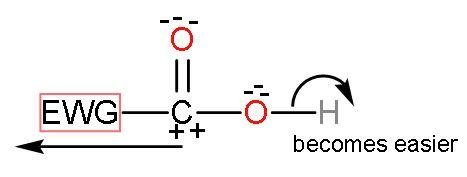
What is the effect of electron withdrawing groups on the acidity carboxylic acid?
Answer
506.4k+ views
Hint: Acidity of a carboxylic acid is mainly determined by the factors like resonance and inductive effect. Here, we will see just one factor; that is how inductive effect affects the acidity of carboxylic acids. Acidity is the ability to produce
Complete answer:
There are two groups under inductive effect, one electron donating groups and another is electron withdrawing groups. Electron withdrawing groups are groups which attract or displace the electrons towards it. The examples of electron withdrawing groups are
Here, X refers to halogens while R refers to alkyl or aryl groups.
Let us now talk about the effect of electron withdrawing groups in acidic strength:
As, the electron withdrawing groups attract electrons away from other elements. So, such groups help in increasing the polarity of the

After the release of

The placement and power of electron withdrawing groups also affect the acidity of compounds:
(1) The inductive effect decreases with increasing carbon chain or increasing distance from the substituted group. So, if an electron withdrawing group is present nearer to the
(2) The power of the electron withdrawing group is also taken into account. More is the power of electron withdrawing groups, more will be the acidic strength of carboxylic acids. Like, 2-nitro ethanoic acid is more acidic than 2-chloro ethanoic acid because the –I effect of the nitro group is more than the chloro group.
Note: The electron withdrawing groups increases the acidity of carboxylic acids. On the other hand, electron donating groups decrease the acidity of carboxylic acids as they decrease the polarity of
Complete answer:
There are two groups under inductive effect, one electron donating groups and another is electron withdrawing groups. Electron withdrawing groups are groups which attract or displace the electrons towards it. The examples of electron withdrawing groups are
Here, X refers to halogens while R refers to alkyl or aryl groups.
Let us now talk about the effect of electron withdrawing groups in acidic strength:
As, the electron withdrawing groups attract electrons away from other elements. So, such groups help in increasing the polarity of the

After the release of

The placement and power of electron withdrawing groups also affect the acidity of compounds:
(1) The inductive effect decreases with increasing carbon chain or increasing distance from the substituted group. So, if an electron withdrawing group is present nearer to the
(2) The power of the electron withdrawing group is also taken into account. More is the power of electron withdrawing groups, more will be the acidic strength of carboxylic acids. Like, 2-nitro ethanoic acid is more acidic than 2-chloro ethanoic acid because the –I effect of the nitro group is more than the chloro group.
Note: The electron withdrawing groups increases the acidity of carboxylic acids. On the other hand, electron donating groups decrease the acidity of carboxylic acids as they decrease the polarity of
Recently Updated Pages
Master Class 12 Business Studies: Engaging Questions & Answers for Success

Master Class 12 English: Engaging Questions & Answers for Success

Master Class 12 Social Science: Engaging Questions & Answers for Success

Master Class 12 Chemistry: Engaging Questions & Answers for Success

Class 12 Question and Answer - Your Ultimate Solutions Guide

Master Class 11 Economics: Engaging Questions & Answers for Success

Trending doubts
Draw a labelled sketch of the human eye class 12 physics CBSE

a Tabulate the differences in the characteristics of class 12 chemistry CBSE

Which one of the following is a true fish A Jellyfish class 12 biology CBSE

Why is the cell called the structural and functional class 12 biology CBSE

Differentiate between homogeneous and heterogeneous class 12 chemistry CBSE

Write the difference between solid liquid and gas class 12 chemistry CBSE




